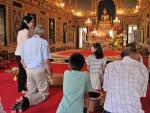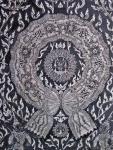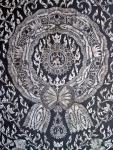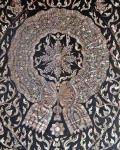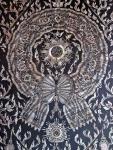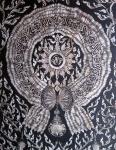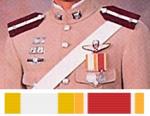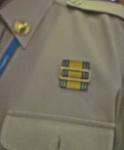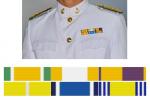-
Posts
249 -
Joined
-
Last visited
Content Type
Profiles
Forums
Blogs
Gallery
Events
Store
Everything posted by Archer
-
See here http://gmic.co.uk/index.php/topic/45316-old-vietnam-medal-or-order/
-
And here is a general view of the interior of this lovely temple. Over at the extreme left you can just see the Royal Orders of Thailand in mother-of-pearl. Cheers! William
-
To give you some idea of the context, here is a picture of one of the shutters (not the same as the shutter from which the enlargements were taken).
-
The second is the Most Noble Order of the Crown of Thailand (Khrueang Ratcha Itsariyaphon An Mi Kiattiyot Ying Mongkut Thai). Established by King Rama V in 1869 for members of the Royal Family, government employees, and foreign dignitaries for outstanding services to the Kingdom of Thailand, it is frequently seen in conjunction with the Order of the White Elephant.
-
Now we come to two Orders that are very familiar to collectors, but which look slightly different to their modern descendants. Bear in mind that these mother-of-pearl decorations date back to the turn of the 20th century. The first is the Most Exalted Order of the White Elephant (Khrueang Ratcha Itsariyaphon An Pen Thi Choet Chu Ying Chang Phueak). Established by King Rama IV in 1861, this is said to be the most frequently bestowed Order in Thailand.
-
Now comes the Ancient and Auspicious Order of the Nine Gems. Established in 1851 by King Rama IV, the Order is bestowed upon members of the Thai Royal Family and distinguished high ranking officials, who have rendered services to the Kingdom and Buddhism. It is said that the Nine Gems originated in a Hindu royal amulet known as the navaratna. In historical times the gems were set in a gold ring awarded to victorious generals, and forming part of the royal insignia given to the king at his coronation. A ring is still part of the insignia of the Order and is worn by male members of the Order. The Nine Gems and the corresponding benefits that they bestow on their bearers, are: Diamond — for power, wealth, success over enemies Ruby — for success and longevity Emerald — for strength and security Yellow Sapphire — for charm and love Garnet — for health and longevity Blue Sapphire — for love and wealth Pearl/Moonstone — for purity, happiness, and success over enemies Zircon/Topaz — for wealth and success in legal affairs Cat’s Eye — for protection by spirits, and from fire
-
The next is a depiction of the Most Illustrious Order of the Royal House of Chakri. This was established by King Chulalongkorn in 1882 to commemorate the Bangkok Centennial. It is awarded to members of the House of Chakri (the Thai Royal Family), foreign Heads of State and members of other royal houses. The colour of the sash is yellow. Note the trident heads projecting behind the star of the order. The Chakri which provides both the name and the emblem of the House of Chakri is composed of a discus (Chakra) and trident (Trisula).
-
Wat Ratchabophit is a Buddhist temple in Bangkok, not far from Wat Pho and the Grand Palace, built during the reign of King Chulalongkorn (Rama V) (1853 – 1910) (reigned 1868-1910). The interior of the temple is rich in Western influence, which dates back to the King's visit to Europe in 1897. From our perspective, the most interesting features are the window shutters decorated with inlaid mother-of-pearl representing the Orders of Thailand! Let's start with a representation of the Most Illustrious Order of Chula Chom Klao. This was established by King Chulalongkorn on 16 November 1873 to commemorate the 90th Jubilee of the Chakri Dynasty, and bears his name (Chula). The colour of the sash is his birthday colour: pink for a Tuesday.
-
Truth is, Dave, we need to get to the bottom of how two lads are wearing ribbons first awarded before either of them was born, and why they are wearing different sets, even though they have just joined the service. Please let me know what more you can find out in country. This one is a real Thai puzzle! Thanks, friend William
-
-
-
But ... These commemorative medals are ALSO worn as singles. This (very poor) photograph was taken of a member of staff in the gift shop at the Royal Palace on Friday last.
-
These "commemorative medals" are frequently seen on the uniforms of members of the civil service. What is immediately noticable is that they are inconsistently worn - in other words, as you see above, near contemporaries wear different sets of ribbons. This set was worn by a lady staff member serving at the Vimanmek Royal Mansion last week. She wears the Orders of the Elephant and the Order of the Crown, but she also wears the new ribbon which Paul Wood has identified as a Commemorative Medal for the Longest Reign Celebration (?? 2008), as well as one of the Red Cross Medals of Appreciation. Put kindly, this woman is old enough to wear others of the Commemorative Medals.
-
Interesting reply, Dave! Thank you I wanted to keep this thread uncomplicated, but you have tempted me to reveal more ... In fact, I made friends with two of these young whiz kids. The second (who is now busy with his doctorate in law!), is 30 years old, born in 1982. He wears the following ribbons: * Silver Jubilee Medal (1971) * Commemorative Medal of HRH Prince Vajiralongkorn's Investiture as Crown Prince (1972) * Commemorative Medal on the Occasion of the Elevation of HRH Princess Sirindhorn to the title of 'Princess Maha Chakri' (1976) * Commemorative Medal on the Occasion of the Longest Reign Celebrations * Commemorative Medal on the Occasion of the 72nd Birthday Anniversary of HM Queen Sirikit (2004) * Commemorative Medal on the Occasion of the 60th Anniversary of the Accession to the Throne of HM King Bhumibol (2006)
-
Thanks Paul - any idea about the first question? It's passing strange.
-
Almost a year ago I visited South-East Asia for the first time, going to Cambodia and Vietnam, equipped with fantastic advice by GMIC member, ThaiDave. I have now had the opportunity to visit Thailand, and in between all the other activities on offer, I was able to pursue my interest in 'phaleristics.' I made friends with a newly-appointed Prosecutor in the Office of the Attorney-General. This department is a corps d'elite - I understand that candidates must possess at least two masters degrees in law from universities outside Thailand. On formal occasions, outside the courts, members wear white court uniform and medal ribbons. (Russian prosecutors do the same.) My new friend is 32 years old. He was born in 1979. His ribbons are: * Commemorative Medal of HRH Prince Vajiralongkorn's Investiture as Crown Prince (1972) * Commemorative Medal on the Occasion of the Elevation of HRH Princess Sirindhorn to the title of 'Princess Maha Chakri' (1976) * Commemorative Medal on the Occasion of the Rattanakosin Bicentennial (1982) * Commemorative Medal on the Occasion of the 6th Cycle Birthday Anniversary of HM King Bhumibol Adulyadej (1999) * Commemorative Medal on the Occasion of the 72nd Birthday Anniversary of HM Queen Sirikit (2004) * ??? So here are my questions: 1. Are these Thai medals hereditary? How could my friend be wearing ribbons of medals awarded before he was born, or issued in his childhood and youth? His father is a very important man. Is he wearing these medals because his father is entitled to wear them? 2. What is the last ribbon on his ribbon bar? Look forward to hearing from you. William
-
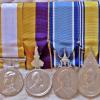
Bought in the Saturday Street Market in Pula, Croatia
Archer replied to Archer's topic in Southern European & Balkan States
Thanks chaps :) -
I was on an organised tour of Pula in Croatia on Saturday, 5 May, when we we were ushered past an antiques street market. "Can you give me five minutes?" I asked the tour guide. "Oh. Don't worry," he replied, "we can walk up that street." Five minutes later I had three Yugoslav Army Commemorative Medals! Cheaper than eBay, and far more meaningful souvenirs than postcards would be! Happiness. (Other tour members looked a little bemused.)
-
I have a recipient who was a student at the South African School of Mines and Technology in Johannesburg. He attested in the Rand Rifles on 9 November 1914, as Private no. 974, and was taken on pay strength on 10 November 1914 - note the dates (cf. Arthur's post above). He is believed to have served in operations against rebels in the northern Orange Free State, between Kroonstad and Ventersburg Road. I do know that the Rand Rifles sailed from Cape Town aboard the Galway Castle in December 1914, landing unopposed in Walvis Bay on Christmas Day, 25 December 1914. Regards William
-
Coming off a low knowledge base ... Can we speak of "fake" French medals, when the official manufacturer, the Monnaie de Paris, continues to churn out insignia years after they were instituted - I even acquired the badge of a Companion of the Order of Liberation there in 2006!
-
I'm looking forward to it hugely!
-
Heh heh! Power of the Forum! Thanks, Chris - thank you for kicking off! C'mon guys - keep 'em coming, please



